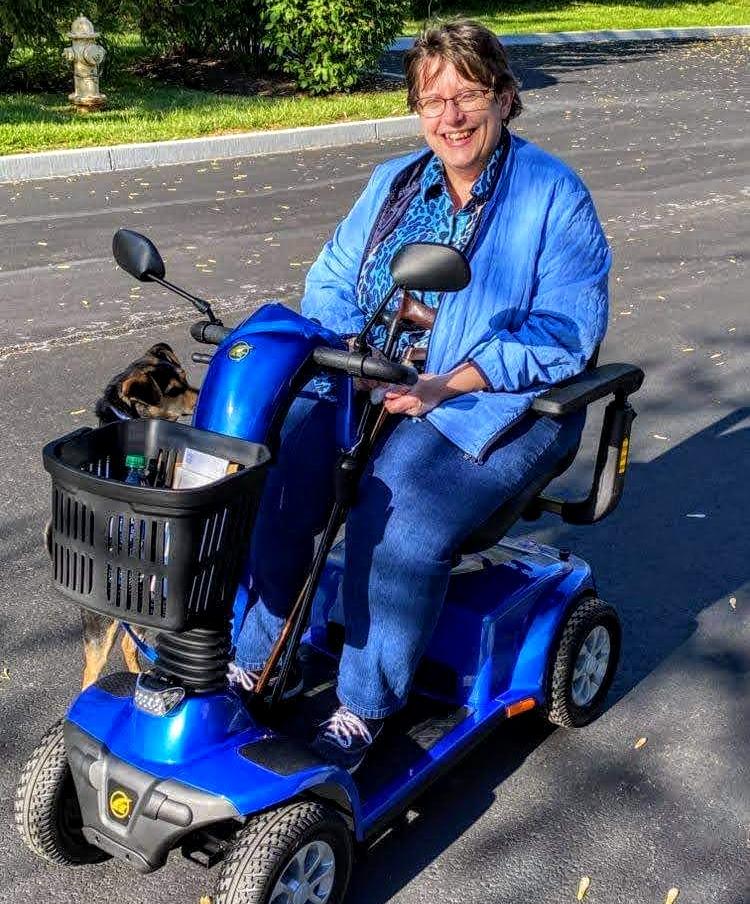Rare Spine Cancer Survivor: “Ain’t Nothin’ Gonna Steal My Joy!”
, by Lynita, Ependymoma Survivor
Lynita has lived with ependymoma for 17 years. She shares how she endured multiple surgeries, radiation, and drug treatments—and has adjusted her life to live fully and joyfully with physical limitations.
My ependymoma came with choices: I could be angry and make everyone around me miserable, or I could choose joy and thank God for every victory. Either way, I would still have cancer. Being bitter wouldn’t change that, but it would change me.
I was 41 years old in January 2005 and had always had “back trouble.” For months leading to my diagnosis, the pain had gotten progressively worse until one morning it reached an excruciating crescendo. Unable to sit, stand, walk, or lie down, I asked my best friend, Bev, to call her chiropractor. She dialed 911.
At the emergency room, X-rays confirmed no skeletal issue. Muscle relaxers were prescribed. Waiting for the car, my left leg gave out and I was admitted to the hospital. A magnetic resonance imaging (MRI) scan revealed a tumor at the base of my spinal cord.
“Livin’ Might Mean Takin’ Chances, but They’re Worth Takin’”
I had emergency surgery as the tumor was breaking apart. Afterward, I couldn’t move my legs. Doctors feared paralysis. But, by God’s grace, I returned to work three months later. It was the first of three times I would need to learn to walk again.
Six weeks of radiation followed. I had three monthly MRIs. When the tumor hadn’t grown, I had imaging every other month. Time between MRIs extended as the tumor continued to be stable. I’ve achieved 12 months between MRIs only once in 17 years.
Following radiation, I was prescribed 18 months of chemotherapy to be taken every three weeks. The side effects weren’t pleasant. Nausea, constipation, diarrhea, exhaustion—and still, the tumor grew.
A second surgery in 2012 and a third in 2015 followed. I gradually lost sensation in my feet and legs. Strength, balance, and bladder control failed. I needed a cane, then a walker, then an electric scooter.
In 2018, I entered a clinical trial for the drug BXQ-350 at the University of Cincinnati. The tumor grew anyway. Steroids were prescribed and medical marijuana was recommended for pain. As a manager for background and drug screening at my job, I knew I couldn’t use marijuana and still keep working. I gritted my teeth and kept my insurance. This was my lowest point. I was physically, mentally, and spiritually drained.
To self-advocate, I researched, documented my symptoms, and peppered my medical team with questions. I wasn’t going down without a fight. My neuro-oncologist met with Mark Gilbert, M.D., at the NCI Center for Cancer Research's Neuro-Oncology Branch (NOB), who was leading a focused study on ependymoma. I also met NOB Neuro-Oncologist Marta Penas-Prado, M.D., who prescribed chemotherapy.
The side effects were worse this time, and—though the risk of paralysis was high—a fourth surgery followed. Neurosurgeon John Heiss, M.D., at NIH, performed the eight-hour resection in 2019, removing bone for better access and then grafting tissue, as multiple incisions had left little to sew back together. I lay flat for 48 hours after surgery to allow the graft to adhere.
Next came monthly infusions of the immunotherapy drug nivolumab as part of a clinical trial at NIH. For the first time in 14 years, the tumor stopped growing. This was monumental! But then COVID-19 hit and travel to NIH became precarious. Dr. Penas-Prado and my neuro-oncologist in Ohio arranged local infusions, then convinced my insurance to continue treatment after the clinical trial ended. Nivolumab is approved for skin and lung cancer, but not ependymoma.
You never know how strong you can be until it’s the only choice you have. My faith sustains me.
“I’ve Still Got a Lot of Fight Left in Me”
I’m still choosing joy, but spinal tumors are no picnic. My travel and wedding photography business perished along with my dream of RV travel. I learned to drive with hand controls when I could no longer feel the pedals. I plan restroom stops where I can drive my scooter into the stall. Visiting requires handrails on steps and a walk-in shower. I bring a shower seat, portable grab bars, and catheter supplies. Twice a year, I undergo surgery to inject Botox into my bladder to prevent leaking. I’m currently continuing nivolumab infusions monthly, along with monitoring MRIs every three months.
To avoid falling, I sit while cooking and use a crockpot or air fryer because lifting pans in and out of the oven can topple me. I have a stair lift to reach my lower level, and a ramp to get in and out of my house. I have my groceries delivered and rely on friends and family to help do things I once took for granted.
All these adjustments have been hard to handle, but I’m blessed with support. I am aware of how much worse my situation could be. I attack obstacles as challenges and do all I can independently.
If ever you feel called to work in the field of medical research, please pursue it. Not all heroes wear capes. Some wear lab coats—and some wear gowns that open in the back. May we all wear our hearts on our sleeve, for the cures are surely out there waiting to be discovered.
